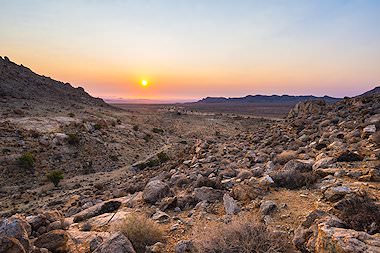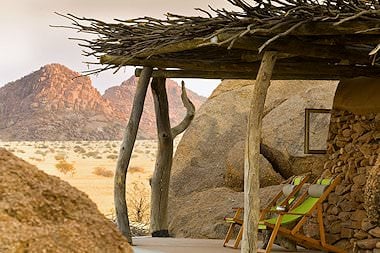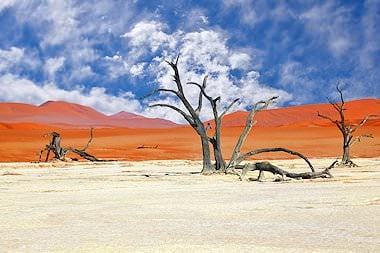Namibia's Skeleton Coast
Help Me Plan- Home
- >
- African Travel
- >
- Namibia
- >
- Skeleton Coast
Skeleton Coast Destination Guide
The Skeleton Coast is a vast, harsh coastline lined with ghostly shipwrecks. It is a no man's land where a hot desert meets a cold ocean along a barren shoreline. There is no drinking water or food. On the beach lies numerous wrecks - a reminder of the disasters that have overcome seafarers on this coast.
Getting to the Skeleton Coast
By Air: You will be welcomed at OR Tambo International Airport and assisted in boarding your flight to Windhoek and onward to Walvis Bay or Swakopmund. If the destination is part of a more extensive Namibian tour, your trip will likely start in Windhoek.
By Road: The Skeleton Coast constitutes approximately one-third of Namibia's coastline and stretches about 650km from Swakopmund to the Angolan border. Guests will be transported to the various destinations on their itinerary through this vast stretch of land via a private, air-conditioned vehicle driven by an experienced guide.
Weather & Best Time To Visit
The area can be visited throughout the year, but is at its best in the spring and summer, from October to March, when the skies are clearer, and there is much less fog than in the cold winter months. If you are visiting one of the more wildlife-rich parks in the area as part of your safari package - the winter months should be considered.

The Skeleton Coast National Park, a seemingly hostile, barren environment, will allow you to experience the mystery and subtlety of nature hidden in its fragile mistiness if you take the time and utilize all your powers of observation. It is a fascinating area, with its history of rumors of "diamond-rich" deposits that lured the hopeful and proved to be an illusion.
Best Private Tours and Safari Packages
The desolate Skeleton Coast will mesmerize you with its one-of-a-kind land and seascapes, while Sossusvlei, with its striking desert landscapes and star-filled skies, will captivate. Etosha National Park offers world-renowned safari experiences.
In Depth Namibia is a private escorted tour to noteworthy attractions in the country. An African Sky guide accompanies the tour.
From Swakopmund, this private tour traverses the Skeleton Coast and Damaraland en route to Etosha National Park.
This five-day package combines an exploration of the Skeleton Coast with some relaxing family time in Swakopmund.
Recommended Accommodation
We recommend the following accommodations to those planning to visit the Skeleton Coast.

Desert Breeze Lodge
This brightly colored lodge is near Swakopmund with a unique desert setting. It offers comfortable, though not luxurious, accommodation.
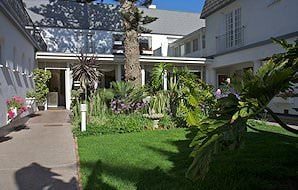
Hansa Hotel
A historic, elegant hotel renowned for its classic ambiance and excellent German-Namibian cuisine. Hansa has a central location in town.
Reasons to visit the Skeleton Coast
Survival of the Fittest
It might sound harsh, but one of the reasons that the Skeleton Coast is so mesmerizing is that it is almost uninhabitable. Amazingly, the environment cannot deter plants and creatures such as lions and elephants. Instead, they adapt to ensure their survival.
Human Traces
It is almost impossible to imagine fauna and flora living in this environment. If you didn't see it with your own eyes, you might not believe that people have been inhabiting this area for hundreds of years. Venture out to the Kunene region, where you can meet the Himba people.
The Skeletons
There is something uncanny yet mesmerizing about the whale, seal, ship, and even human skeletons strewn across the coastline – half disappearing into the sand, half obscured by fog. Again, it is a feeling of immense humility as you realize the power of Mother Nature.
Experiences to Savor
Experiences are about familiarizing yourself with Namib's desolate coastline, the contrast between the wreckage of the dead ships, and the abundance of marine life that thrives here.

That Ship has Sailed
It is impossible to forget the imagery of the shipwrecks along the Skeleton Coast, covered by a blanket of fog billowing in from the ocean, disappearing in part under the sands blown in with the strong winds. The picture is guaranteed to stay with you forever.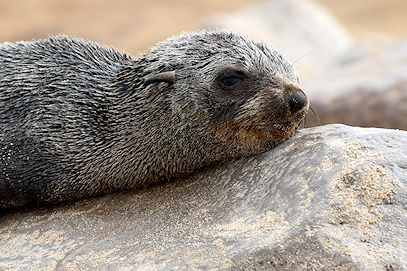
Seal the Deal
The size of the colony of Cape fur seals that inhabit a section of the coast is unimaginable and almost indescribable. You have to see, hear, and, for that matter, smell. These seals feed on the bounty in the cold Atlantic Ocean.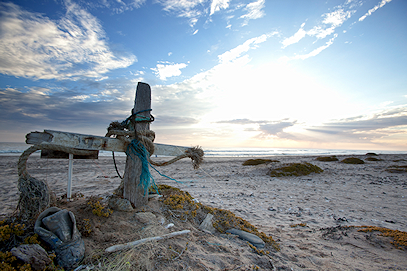
Unforgettable Landscapes
Vast, harsh, and hauntingly beautiful, the Skeleton Coast has such a unique variety of landscapes and features that you are often stunned to silence. It is a landscape photographer's dream, so remember your camera.Useful Information
History
The name 'Skeleton Coast' was given to this lonely stretch of land due to all the whale and seal bones that littered the coast when large-scale whale hunting was in its heyday and seals were hunted for oil, fur, and protein. The first recorded use of the name "Skeleton Coast" was by a newspaperman, Sam Davies, in 1933. This coast is also no stranger to human skeletons of sailors stranded in this unforgiving landscape. Before that, the Portuguese sailors referred to this area as 'the Gates of Hell' and, earlier still, the stone-age Bushmen called it "The Land God Made in Anger." The area is best known for the shipwrecks dotting the coast. More than a thousand ships have met their end here.
Many ships were stranded here due to the dense fog around the coastline. The fog is caused by the cold, moist air traveling over the icy waters of the Benguela current that collides with the warm atmosphere of the Hadley Cell. On average, the region experiences 180 days of fog a year. Small boats could land on the beach, but the strong Atlantic surf made it impossible for them to launch again. An unnamed vessel stranded in 1860 was found in the 1940s. Alongside it were a dozen skeletons and a slate reading: "I am proceeding to a river 60 miles north, and should anyone find this and follow me, God will help him."
Wildlife
For such a barren landscape, there is a surprising amount of wildlife. The largest land mammal of all, the famous desert-adapted elephant, survives in this harsh environment. These elephants have been known for going without water for three days, then drinking up to 230 liters of water when they find it. Elephants and baboons dig down in riverbeds to gain access to water that then enables other species to quench their thirst. Even the endangered black rhinoceros makes a living here. The most abundant mammal would be the Cape fur seal, of which approximately 200 000 are along the coastline.
Even lions visit the coast to utilize the abundance of seals. Scavengers include black-backed jackals and brown hyenas that comb the beach for carrion. Killer whales hunt the seals in the water, and humpback whales and Heaviside's dolphins occur. Desert-adapted gemsbok and springbok are the main antelope species in the area. Birds are plentiful, with 247 species already documented. The largest bird of all – the ostrich – is found here, and large colonies of marine birds, such as cormorants, nest on some of the old shipwrecks. It is also one of few places where the near-endemic Damara is spotted. Highly specialized desert reptiles and insects are plentiful.
Vegetation & Terrain
The Skeleton Coast is renowned for its hauntingly beautiful terrain. The landscape includes untouched wind-swept dunes, rocky gullies, and mountain ranges. A dense coastal fog's regular occurrence adds to the region's mystery and wonder.
The northern parts of the Skeleton Coast have protected wilderness areas, and guests can only visit on exclusive safari tours. These areas include the clay castles of the Hoarisib and the salt pans of the Agate Mountain. The vegetation is considered Northern Namib and relatively sparse, the most common being the dollar bush, brakspekbos, and lichens. Most of the plant species found on the Skeleton Coast rely on the coastal fog for survival. Four rivers cross the area: Ugab, Huab, Koichab, and Uniab. The rivers rarely flow, and when they do, only for a short period.
Activities
Exploring the vastness of the area is best done by driving in a 4x4 vehicle. A scenic flight over the region gives visitors an altogether altered perspective, often described as otherworldly. Suppose you want to keep your feet firmly on the ground. In that case, guided nature walks are an excellent way to immerse yourself in the stunning scenery and inspect the vegetation, mammals, and birds that have adapted to survive in the harsh desert environment. The region offers some of the unique safaris in Namibia.
The Cape Cross Seal Reserve is home to a large breeding colony of Cape fur seals. There are estimated to be between 150 000 to 200 000 seals. The area has a distinctive smell and sound, and you can be sure you will remember it. Guests can also visit the nearby Cape Cross, where the Portuguese navigator Diego Cão erected a stone cross in 1486. Anglers can make their way to Henties Bay, one of the region's premier fishing spots.

